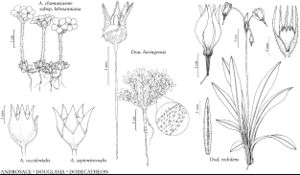Difference between revisions of "Androsace septentrionalis"
Sp. Pl. 1: 142. 1753 ,.
FNA>Volume Importer |
FNA>Volume Importer |
(No difference)
| |
Revision as of 20:29, 24 September 2019
Plants annual or biennial, highly variable in size from inconspicuous to moderately robust, not mat-forming. Leaves in single rosette; petiole obscure to absent; blade oblanceolate to spatulate, 5–30 × 3–10 mm, base obscurely narrowing to stem, margins often ciliate, surfaces glabrescent to hairy, hairs straight. Scapes 1–5(–10), 1–10(–15) cm, glabrescent, puberulent, or, sometimes, stipitate-glandular. Inflorescences 5–20-flowered; involucral bracts narrowly lanceolate to linear-lanceolate, relatively narrow. Pedicels erect to arcuate, slender, unequal, 0.3–6 cm. Flowers: calyx narrowly campanulate, with prominent ridges, 3–5 mm, lobes erect, broadly lanceolate, apex acute; corolla tube equaling or shorter than calyx, limb to ca. 3 mm diam. Capsules ± equaling calyx, 3–5 mm. 2n = 20.
Phenology: Flowering spring–early fall.
Habitat: Open areas with sandy, gravelly soil in grassland, shrub, forest, and tundra communities
Elevation: 0-3500 m
Distribution

Greenland, Alta., B.C., Man., Nfld. and Labr. (Nfld.), N.W.T., Nunavut, Ont., Que., Sask., Yukon, Alaska, Ariz., Calif., Colo., Idaho, Minn., Mont., Nev., N.Mex., N.Dak., Oreg., S.Dak., Tex., Utah, Wash., Wyo., Eurasia.
Discussion
Androsace septentrionalis is broadly distributed and ruderal, occurring from low elevations at high latitudes to the alpine tundra in the Rocky Mountains. It is the most common species of Androsace across western North America and is variable in morphology, depending on elevation, exposure, and light. This plasticity has resulted in a plethora of infraspecific names. Most infraspecific taxa show little geographic coherence, and variants representing all the infraspecific taxa can be found throughout the range of this species, sometimes mixed within single populations. High-elevation individuals tend to have very short scapes and a diminutive growth habit; lowland individuals begin flowering when the scapes are barely developed, and elongate throughout anthesis, ultimately often producing robust individuals with relatively tall scapes. Shaded areas produce plants with “long” pedicels; exposed areas produce plants with “very short” ones. The location and degree of glands and other hairs can vary widely as well. The most readily identifiable morphotype is subsp. glandulosa, seen most commonly in Arizona, southern Colorado, New Mexico, and Texas; even in it, nonglandular individuals occur together with glandular plants. Given the lack of coherence in morphological variation within A. septentrionalis and its environmental variation, it seems best to view the complex as a single, highly variable species.
Selected References
None.
